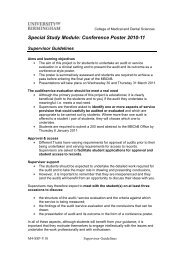Contents - College of Medical and Dental Sciences - University of ...
Contents - College of Medical and Dental Sciences - University of ...
Contents - College of Medical and Dental Sciences - University of ...
Create successful ePaper yourself
Turn your PDF publications into a flip-book with our unique Google optimized e-Paper software.
The 11 th International Workshop on KSHV & Related Agents, Birmingham, UK<br />
Virus-Cell Interactions I Abstract 25<br />
ROLE OF DEFECTIVE OCT-2 AND OCA-B EXPRESSION IN IMMUNOGLOBULIN<br />
PRODUCTION AND KSHV LYTIC REACTIVATION IN PRIMARY EFFUSION<br />
LYMPHOMA<br />
Daniel DiBartolo 1 , Elizabeth Hyjek 1 , Shannon Keller 1 , Ilaria Guasparri 1 , Ren Sun 2 , Amy<br />
Chadburn 1 , Daniel M Knowles 1 , <strong>and</strong> Ethel Cesarman 1<br />
Department <strong>of</strong> Pathology <strong>and</strong> Laboratory Medicine, Weill Cornell <strong>Medical</strong> <strong>College</strong>, New<br />
York, NY, 1 Molecular Biology IDP, <strong>University</strong> <strong>of</strong> California at Los Angeles, Los Angeles,<br />
CA 2<br />
Abstract<br />
PEL cells do not express surface or cytoplasmic immunoglobulin (Ig) despite having a<br />
genotype <strong>and</strong> gene expression signature <strong>of</strong> highly differentiated B cells. We show the<br />
lack <strong>of</strong> Oct-2 <strong>and</strong> OCA-B transcription factors to be responsible, at least in part, for this<br />
defect in Ig production. ORF50/Rta, the major regulator <strong>of</strong> KSHV lytic reactivation,<br />
contains an octamer motif within its promoter. Thus, we also examined the impact that<br />
the lack <strong>of</strong> Oct-2 <strong>and</strong> OCA-B have on lytic reactivation mediated by ORF50. Previous<br />
studies had shown that binding <strong>of</strong> Oct-1 to the ORF50 promoter significantly enhances<br />
ORF50 transactivation. However, we found that Oct-2, on the other h<strong>and</strong>, inhibits ORF50<br />
expression <strong>and</strong> consequently lytic reactivation. Chromatin immunoprecipitation assays<br />
showed that endogenous Oct-1 associates with ORF50 promoter in uninduced cells <strong>and</strong><br />
transfection <strong>of</strong> ORF50 further enhances its binding. Using PEL cells with inducible Oct-2<br />
expression we found that induction <strong>of</strong> Oct-2 results in Oct-2 association with the ORF50<br />
promoter <strong>and</strong> decreased Oct-1 binding suggesting that Oct-2 competes with Oct-1 for the<br />
octamer site in the ORF50 promoter, explaining mechanistically the observed inhibitory<br />
effect on lytic reactivation. The consistent absence <strong>of</strong> Oct-2 in PEL leads us to speculate<br />
that this deficiency is selected for in order to maintain the ability to efficiently transition<br />
from latency to lytic reactivation.<br />
Presenting author Email: ecesarm@med.cornell.edu<br />
48















